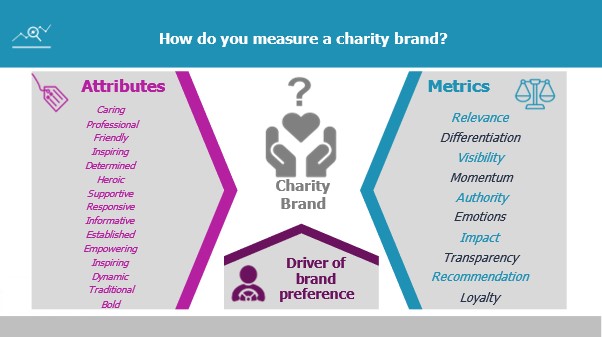This question must have been asked by every brand specialist and marketing person at some point. What can I say, it’s a challenging task…
If you are reading this blog, I hope I am in a safe space, so I can skip the part where I outline the importance of brand and how it should always be at the centre of our day-to-day work. You know, the stuff about how we should be living our brand, breathing our brand, and eating it for breakfast!
First things first, let’s admit it’s difficult to move the scale on awareness measures, full stop. One-dimensional awareness measures can be exhausting and disheartening, that’s not to say they aren’t a valuable tool for measuring success, but they can sometimes blind us (or our Trustee boards or executive teams), forbid us from seeing the broader picture, and hinder valuable gains we might be achieving if we were to look beyond simple awareness figures. Hence the reason why this blog will be looking beyond awareness for a change. I am sure the majority of people in marketing and comms teams have been in a situation where they have moved mountains with the resources they have and are yet to see a significant increase in their prompted awareness – however this is often the expectation from Trustees.
I understand you and I feel your pain – and that is why I am offering to look beyond the usual KPIs and move towards other objectives and key results that also matter.
Some of you know that at nfpSynergy we track brands with a wide range of audiences and via different tools. For instance, we track the brand health journey basic stepping stones such as awareness, understanding, support and trust via our main model, the Charity Awareness Monitor. But this week’s blog will delve deeper into the story of a different framework, the Charity Brand Evaluator, a tool that aims to look beyond awareness and reveal other dimensions of a charity brand such as personality, visibility and differentiation.
Why do we need to do this? One of the most important reasons is that research confirms that a charity's brand assists income generation and donor engagement – so we absolutely need to explore all of the dimensions of charity brands and understand which traits are driving support – our Charity Brand Evaluator tries to do exactly this.
Can we measure charity brands effectively? We believe that there is no single way of doing this. More than a couple of years ago, we sat down with a team of researchers and created a framework that is both flexible but also tailored enough that all our participant brands can find a relevant set of metrics to track in the long-term.
We have built this model by doing a thorough literature review, but also tapping into our own expertise within the voluntary sector. More practically, we have spoken to brand professionals in the charity world to understand their priorities and must-haves in a brand tracker, but also took cues from corporate brands and learned from them how they do it.
So, the Charity Brand Evaluator was born! An online survey of 1,000 members of the British general public who are aware of each charity and know it well enough to answer questions. So not a nationally representative sample, because we know from our other research, if we want to see beyond awareness, we have to speak to people who know about your brand and know it well enough to answer more in-depth brand personality type questions.

We start with finding out what people think of a brand, by prompting a set of attributes, such as Caring, Professional, Friendly etc. This lets us measure each brand’s personality with a set of appropriate attributes. Achieving differentiation in the charity sector is especially difficult as we are all under the same overpowering umbrella brand of being a ‘charity’ – so some of the traits come with this umbrella, such as caring, supportive, compassionate. For instance, our research shows that the benevolent characteristics of being caring, compassionate, supportive, transparent, honest, trustworthy, and helpful were all traits that were associated with the notion of the ideal charity. This is why the Charity Brand Evaluator is a great tool if you want to see where you meet the public’s ideal, and it teases out exactly where your personality differs from others.
In the Charity Brand Evaluator, we ask not just about brand attributes but a range of other questions. Such as if charities are considered relevant or visible or to be making an impact. In addition, we also ask a simple question of ‘how much do you like this brand?’ By layering these findings over each other, we conduct a statistical analysis called a Driver Analysis. This explores the relationship between these questions, and determines how strong each of them is in predicting brand preference. Driver Analysis show how we are tracking metrics that matter for your brand (rather than a standard prompted awareness measure). Briefly this analysis helps us see which metrics actually drive support for your brand.
Charity Brand Evaluator (CBE) takes place bi-annually in Spring and Autumn and offers a ‘deep dive’ into perceptions of your charity brand’s personality.
Each charity nominates one comparator brand and chooses 5 out of 10 metrics which are explored in detail, these are: Differentiation, Visibility, Momentum, Relevance, Impact, Loyalty, Authority, Transparency, Recommendation, and Emotional Responses. Qualitative data (open ended responses) are also collected for one of the metrics.
As standard, we also collect data on the ideal charity in a range of sectors, attributes associated with each charity, how much respondents like each charity, and any changes over time.
Get in touch with us on CBE@nfpsynergy.net to arrange a quick tour of what the Charity Brand Evaluator can tell you about your brand.

